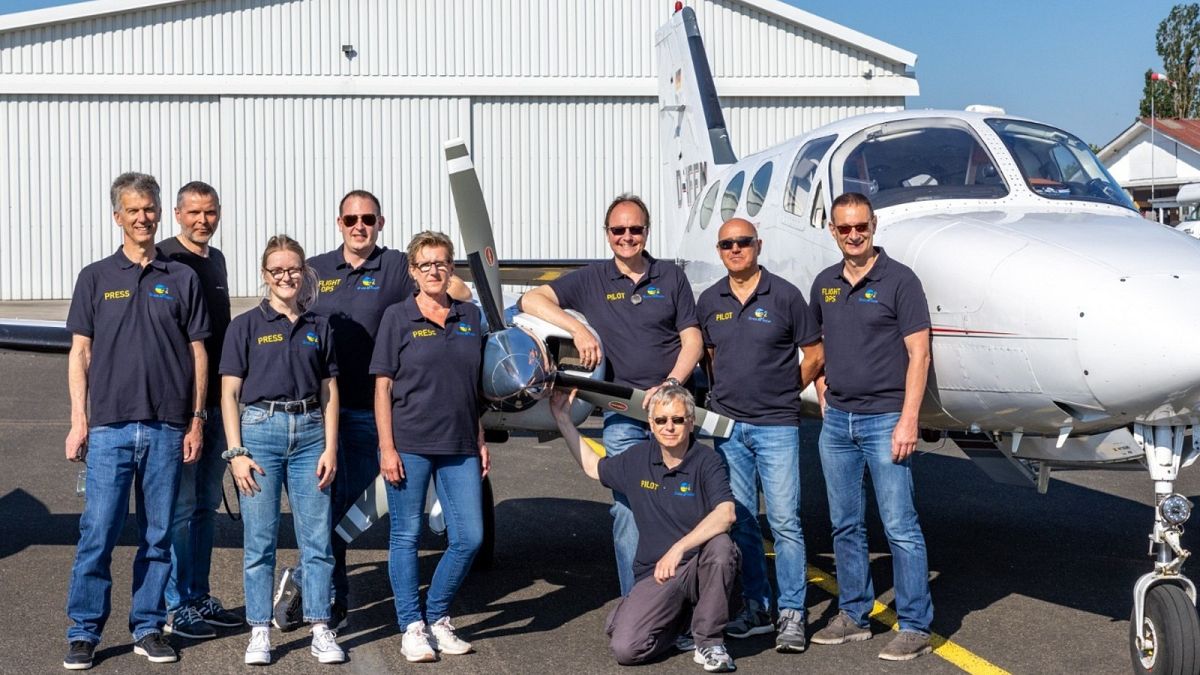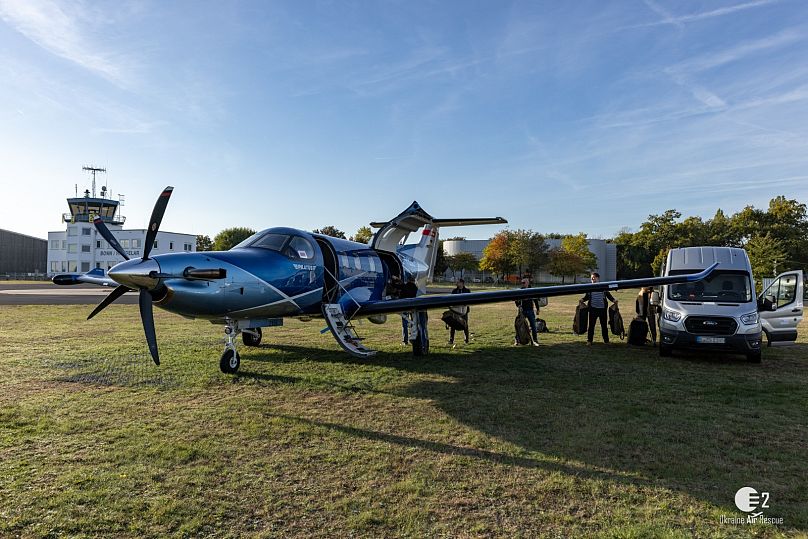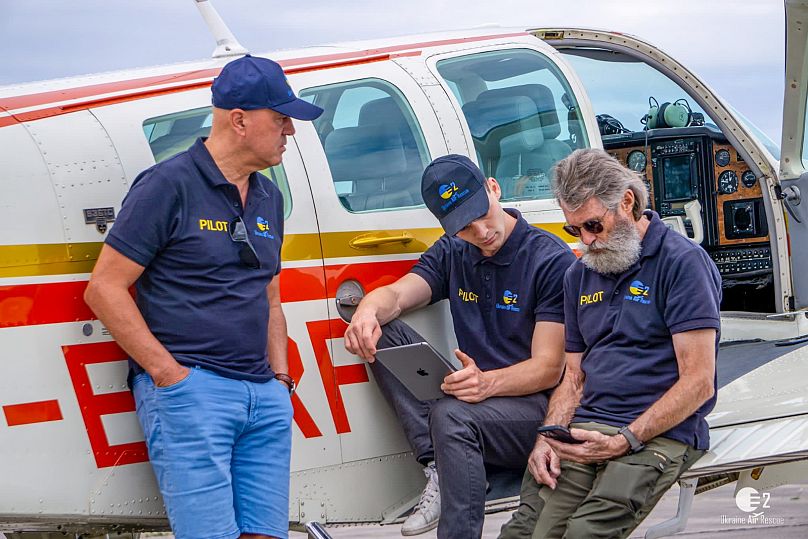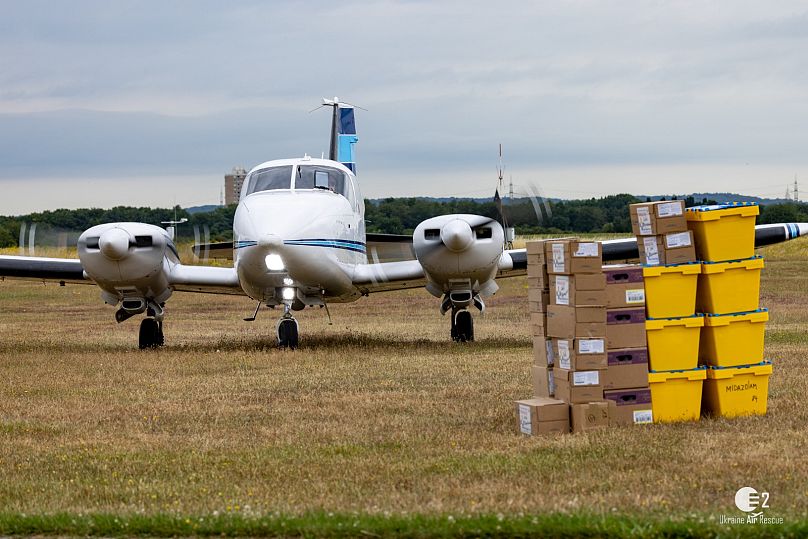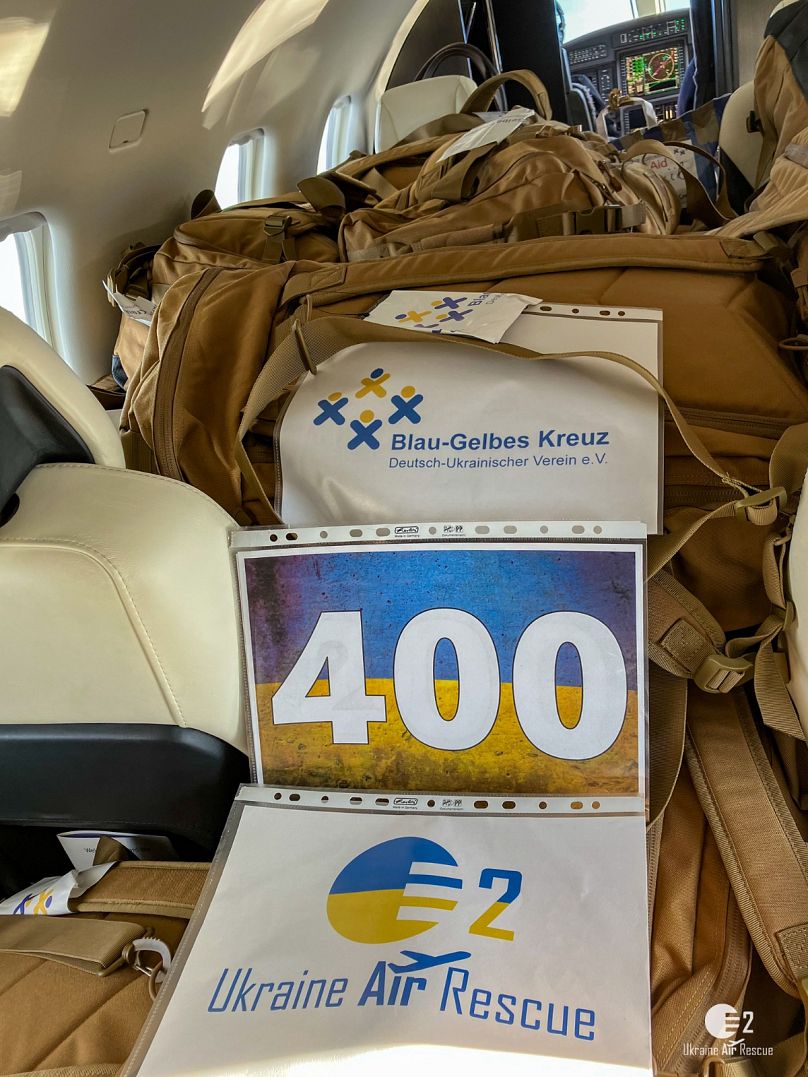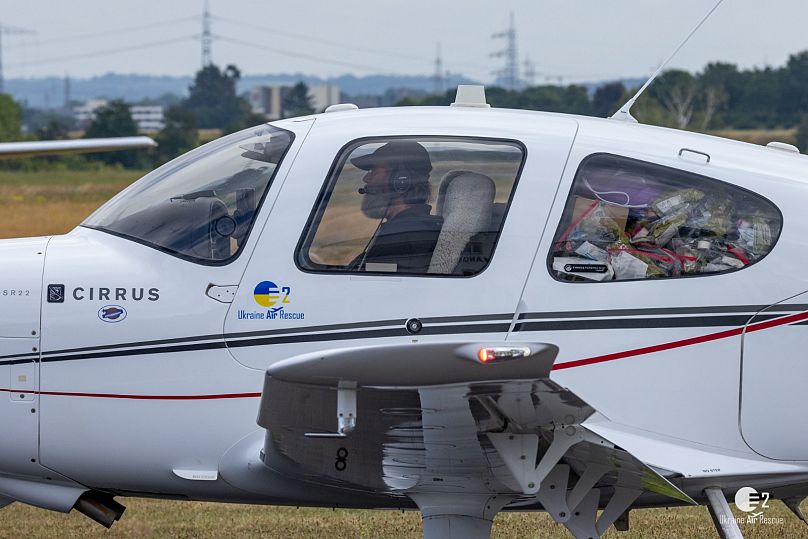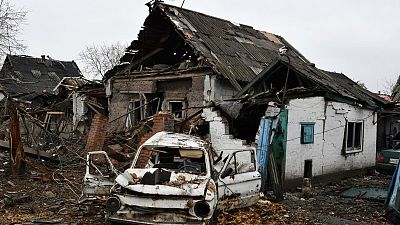Above and beyond: Europeans behind huge air relief effort for Ukraine
Two Germans with a passion for aviation are behind what is claimed to be the largest aerial civilian humanitarian aid operation in history. Here is the story of Ukraine Air Rescue and its pilots.
As Kay Wolf and Stephan Sahling watched the news of Moscow’s full-scale invasion of Ukraine unfold on 24 February, the two German IT security experts immediately sprung to action.
The long-time friends have several passions in common, but it was their shared love of aviation — Sahling is a pilot of more than 15 years and Wolf an enthusiast — that made them devise a plan on the spot.
They would use small, privately owned aircraft to fly as close to Ukraine as possible to deliver much-needed aid.
“After a few days (following the invasion), Stephan called me and asked me how I was doing, because he knows I served 10 years in the army and I have seen a lot (in terms of) what the war can do to soldiers and civilians alike,” Wolf told Euronews.
“We talked about the situation, whether we could make donations, or how we could really help.”
“Both of us come from manufacturing, so we know processes very well. We have also been working in IT for 20-30 years, so we know the tools, and we can fly.”
The duo immediately started making calls to other pilots and aircraft owners, enlisting friends and friends of friends.
In just a couple of days, Ukraine Air Rescue was born — and airborne.
'Largest civilian humanitarian air relief effort in human history'
What they originally thought would be a small-time operation much akin to a local flying club grew to a large-scale undertaking involving 381 registered pilots from almost all continents, Wolf told Euronews.
The planes, some lent by those who could not participate in themselves, range from two-seater Cirruses and French propeller-nosed Robins to much larger Pilatus PC-12s and everything in between.
Everyone is a volunteer, Wolf emphasised. Some donate funds, while others share piloting knowledge.
Others are volunteering their skill and experience behind the stick — including retired or current airline and military pilots, an EASA safety inspector and a Lufthansa flight instructor — spending multiple hours in the cockpit on flights to the Mielec airport on the Polish-Ukrainian border and back.
“Some are able to come over for one or two weeks, rent aeroplanes in Europe and fly,” Wolf explained. “Some can maybe do it in the spring, or at a later time.”
“We had pilots who decided to spend their vacation by coming to Germany and then they were flying.”
The initiative has gone truly international. The Ukraine Air Rescue pilots, who come from 30 countries, have used airports from Germany to the US and Belgium to the UK to deliver everything from time-sensitive medication, first aid kits and dialysis equipment to the Ukrainian border.
When the town of Bucha was liberated from the Russian troops in early April, the Ukraine Air Rescue pilots were the ones who flew in body bags and rape kits after evidence emerged that Moscow forces had committed a series of atrocities during the month-long occupation.
On their way back, the pilots brought refugees and those in need of immediate medical care to the EU.
Some of those evacuated were Ukrainian soldiers who have lost limbs in the fighting, with the view of having German prosthetics specialists give them a new lease on life.
'I didn't give it a lot of thought'
One of the pilots who immediately joined the team is a 71-year-old Florida native John Bone, a former Delta Airlines captain who has been in the cockpit since he was a teenager.
Bone, a wiry man with a long silver beard, is a well-known flight instructor in his hometown of Apalachicola who flew around the world twice before.
After receiving the call from Wolf, he simply got into his Cirrus SR22 — first to Canada, then Greenland, Iceland and Scotland, a trip that took five days — and came to Germany as if it were a breeze.
He knew the route by heart, having spent a significant part of his career at Delta flying transatlantic passenger planes from Atlanta to Frankfurt.
“Honestly, I didn’t give it a lot of thought,” Bone told Euronews.
“They said ‘we could use a guy’. I said down with my wife and I said, ‘you know, I got to do this.’”
Bone knew he wanted to help those in need in a war zone, but he was also intrigued by the idea itself.
“When I heard how this was working, I thought, this is an interesting situation where general aviation, small planes come together for a humanitarian mission. It’s effective.”
“I wouldn’t have gone over there if I wasn’t convinced that what I was going to be doing was going to make a significant contribution,” he said.
More than 22 tonnes of aid have been delivered since February on more than 80 flights, some involving multiple aircraft, making the Ukraine Air Rescue the largest civilian air relief operation in world history, Bone and Wolf believe.
But not everything has been smooth sailing. One of the major challenges the Ukraine Air Rescue encountered comes with using small civilian aircraft.
Flights can last up to a dozen hours in one direction depending on the type of aeroplane and its cruising altitude, and using small local airports means that pilots do not have much in terms of technological assistance for take-off and landing.
These routes are not for those less passionate about flying or dedicated to the cause.
“Weather’s an issue because we leave from small VFR (Visual Flight Rules) airports, and our destination, Mielec, is also a VFR airport.”
“These are not airports that you can operate out of when there’s bad weather,” Bone explained.
“And they’re 550 nautical miles (1018 kilometres) out there, so this summer there were thunderstorms, weather systems and all of that. And all of that factors into this.”
But Wolf and Sahling run a tight ship, Bone explained. There are multiple briefings before departure. Simpler aircraft are switched out for better-equipped — and more expensive — ones in case of inclement weather.
Everything is numbered, weighed and manifested, and the safety of the pilots and their precious cargo is Wolf’s round-the-clock priority.
Bureaucracy main obstacle to aid delivery?
The operation has received the attention of many NGOs who have since partnered up with Ukraine Air Rescue, including the Blue Yellow Cross, Munich Supports Ukraine, Cologne’s City of Hope and others.
A US-based company that specialises in producing solar-powered coolers and stoves for emergency situations and in countries with limited access to the electricity grid, GoSun, has also donated its equipment for the effort.
Yet large organisations and governments are a different matter. The support has been more than just lacking, even in his native Germany, Wolf said.
“To make this quite clear, currently, people are dying because of them.”
Ukraine Air Rescue has several tonnes in medication donations on nearly 100 pallets waiting in the United States and a deal with a US cargo company to fly it to Europe, Wolf explained.
But governments in Germany and Poland are asking the organisation to pay taxes for what they deem to be imported goods.
As an initiative of volunteers, Ukraine Air Rescue does not have the kind of funds needed to cover the taxes.
Just seven pallets of medication Ukraine Air Rescue planned to fly to Ukraine in the autumn, estimated to be worth €2 million, came with a €380,000 tax charge in Germany. In Poland, they would have to pay €560,000.
“It’s taxed because some government people are just following the rules, and they are saying, as soon as something leaves the cargo area, it is possible you are selling the medication in Germany in Poland,” he outlined.
“But if we can prove that the cargo is leaving the EU to Ukraine, then we can make a request to get the money back. And this can happen by the end of the year, or maybe after 90 days.”
Months of negotiating a solution have made Wolf and others feel very frustrated.
“These are humanitarian penalties. And the US cargo company has already paid €50,000 and are now asking for a statement from a European government that there will be no further taxes.”
“We spoke to the German government to get a written statement in support. And we did not get it.”
But the likes of Wolf and Bone are undeterred: Ukraine Air Rescue plans to continue delivering the much-needed aid for as long as it takes.
The next step is finding a way to fly into Ukraine with no stops in between.
“During our first brainstorms, our plan was to fly to Ukraine directly because there are some airports just 50 or 100 metres beyond the Polish border, but for political reasons, we didn’t do this,” Wolf said. “But the plan is for sure to create a hub in Ukraine."
"We are in discussions with the Ukrainian pilot organisation to support us in finding the right places in the country where airports have not been destroyed.”
“And also, most of our aeroplanes can land on grass or on streets,” Wolf concluded.


